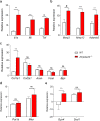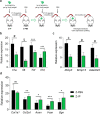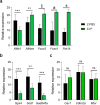Systemic transplantation of adult multipotent stem cells prevents articular cartilage degeneration in a mouse model of accelerated ageing
- PMID: 34098983
- PMCID: PMC8183038
- DOI: 10.1186/s12979-021-00239-8
Systemic transplantation of adult multipotent stem cells prevents articular cartilage degeneration in a mouse model of accelerated ageing
Abstract
Background: Osteoarthritis (OA) is one of the most prevalent joint diseases of advanced age and is a leading cause of disability worldwide. Ageing is a major risk factor for the articular cartilage (AC) degeneration that leads to OA, and the age-related decline in regenerative capacity accelerates OA progression. Here we demonstrate that systemic transplantation of a unique population of adult multipotent muscle-derived stem/progenitor cells (MDSPCs), isolated from young wild-type mice, into Zmpste24-/- mice (a model of Hutchinson-Gilford progeria syndrome, a condition marked by accelerated ageing), prevents ageing-related homeostatic decline of AC.
Results: MDSPC treatment inhibited expression of cartilage-degrading factors such as pro-inflammatory cytokines and extracellular matrix-proteinases, whereas pro-regenerative markers associated with cartilage mechanical support and tensile strength, cartilage resilience, chondrocyte proliferation and differentiation, and cartilage growth, were increased. Notably, MDSPC transplantation also increased the expression level of genes known for their key roles in immunomodulation, autophagy, stress resistance, pro-longevity, and telomere protection. Our findings also indicate that MDSPC transplantation increased proteoglycan content by regulating chondrocyte proliferation.
Conclusions: Together, these findings demonstrate the ability of systemically transplanted young MDSPCs to preserve a healthy homeostasis and promote tissue regeneration at the molecular and tissue level in progeroid AC. These results highlight the therapeutic potential of systemically delivered multipotent adult stem cells to prevent age-associated AC degeneration.
Keywords: Accelerated ageing; Adult stem cells; Articular cartilage; Progeria; Regenerative medicine; Transplantation.
Conflict of interest statement
The authors declare that they have no competing interests.
Figures




Similar articles
-
Sex-specific preservation of neuromuscular function and metabolism following systemic transplantation of multipotent adult stem cells in a murine model of progeria.Geroscience. 2024 Feb;46(1):1285-1302. doi: 10.1007/s11357-023-00892-5. Epub 2023 Aug 3. Geroscience. 2024. PMID: 37535205 Free PMC article.
-
Systemic Transplantation of Adult Multipotent Stem Cells Functionally Rejuvenates Aged Articular Cartilage.Aging Dis. 2021 Jun 1;12(3):726-731. doi: 10.14336/AD.2020.1118. eCollection 2021 Jun. Aging Dis. 2021. PMID: 34094638 Free PMC article.
-
Rapamycin Rescues Age-Related Changes in Muscle-Derived Stem/Progenitor Cells from Progeroid Mice.Mol Ther Methods Clin Dev. 2019 May 30;14:64-76. doi: 10.1016/j.omtm.2019.05.011. eCollection 2019 Sep 13. Mol Ther Methods Clin Dev. 2019. PMID: 31312666 Free PMC article.
-
Roles of articular cartilage aging and chondrocyte senescence in the pathogenesis of osteoarthritis.Iowa Orthop J. 2001;21:1-7. Iowa Orthop J. 2001. PMID: 11813939 Free PMC article. Review.
-
Mesenchymal chondroprogenitor cell origin and therapeutic potential.Stem Cell Res Ther. 2011 Feb 18;2(1):8. doi: 10.1186/scrt49. Stem Cell Res Ther. 2011. PMID: 21371355 Free PMC article. Review.
Cited by
-
AIDS patients suffer higher risk of advanced knee osteoarthritis progression due to lopinavir-induced Zmpste24 inhibition.Bone Res. 2025 Jun 3;13(1):58. doi: 10.1038/s41413-025-00431-2. Bone Res. 2025. PMID: 40461512 Free PMC article.
-
Patchouli Alcohol Inhibits D-Gal Induced Oxidative Stress and Ameliorates the Quality of Aging Cartilage via Activating the Nrf2/HO-1 Pathway in Mice.Oxid Med Cell Longev. 2022 Jun 8;2022:6821170. doi: 10.1155/2022/6821170. eCollection 2022. Oxid Med Cell Longev. 2022. PMID: 35720186 Free PMC article.
-
Sex-specific preservation of neuromuscular function and metabolism following systemic transplantation of multipotent adult stem cells in a murine model of progeria.Geroscience. 2024 Feb;46(1):1285-1302. doi: 10.1007/s11357-023-00892-5. Epub 2023 Aug 3. Geroscience. 2024. PMID: 37535205 Free PMC article.
-
Extracting high-quality RNA from formaldehyde-fixed naturally aged neuromusculoskeletal tissues.Biotechniques. 2024 Apr;76(4):153-160. doi: 10.2144/btn-2023-0092. Epub 2024 Feb 9. Biotechniques. 2024. PMID: 38334498 Free PMC article.
References
-
- Verzijl N, DeGroot J, Ben ZC, Brau-Benjamin O, Maroudas A, Bank RA, et al. Crosslinking by advanced glycation end products increases the stiffness of the collagen network in human articular cartilage: a possible mechanism through which age is a risk factor for osteoarthritis. Arthritis Rheum. 2002;46(1):114–23. doi: 10.1002/1529-0131(200201)46:1<114::AID-ART10025>3.0.CO;2-P. - DOI - PubMed
-
- DALYs GBD, Collaborators H Global, regional, and national disability-adjusted life-years (DALYs) for 333 diseases and injuries and healthy life expectancy (HALE) for 195 countries and territories, 1990–2016: a systematic analysis for the Global Burden of Disease Study 2016. Lancet. 2017;390(10100):1260–344. doi: 10.1016/S0140-6736(17)32130-X. - DOI - PMC - PubMed
Grants and funding
LinkOut - more resources
Full Text Sources

